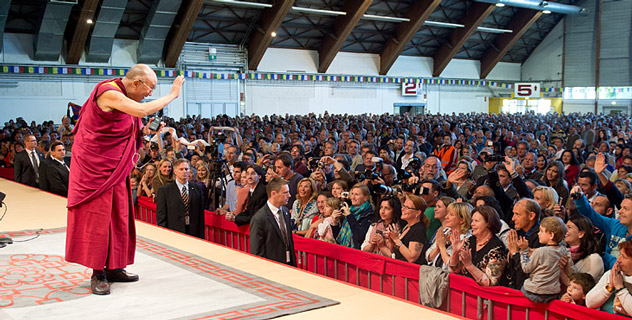Fourth part of His Holiness the Dalai Lama’s teachings in Klagenfurt Austria May 18-20, 2012 translated from Tibetan into English by Mr Tenzin Tsepag. Trascript by Dr. Peter Lawrence-Roberts, first revision and editing by Dr. Luciano Villa within the project “Free Dalai Lama’s Teachings” for the benefit of all sentient beings. We apologize for possible errors and omissions.
His Holiness the Dalai Lama – The Song of the Four Mindfulnesses https://www.sangye.it/altro/?p=4680
This test came initially from Lama Tsong Khapa and then went to the first Dalai Lama who passed it down.
On the unwavering cushion of the union of method and wisdom
Sits the kind Lama who is the nature of all protectors.
There is a Buddha in the state of culmination of realizations and cessations.
Beseech him in the light of admiration, through casting away critical thoughts.
Don’t let your mind go astray, but place it within admiration and reverence.
Through not losing mindfulness, hold it within admiration and reverence.
The first verse remembers the deep aspiration and respect toward the teacher and is related strongly to the Vajrayana teachings. It is really focussing on one’s own teacher. The lama refers to the ultimate lama, the clear light mind, which is at our heart between the indestructible red and white lights. This is one’s own lama, yidam and mind. We experience these as one entity or one taste. So, within the innate clear light mind the lama, the yidam and one’s own mind are of one taste. So the verse is focussed on recognising one’s ultimate lama – one’s own clear light mind.
In unending samsara, the prison of suffering, Wander the sentient beings of the six realms, bereft of happiness.
They are your parents, who reared you with affectionate kindness.
Meditate on compassion and affection by relinquishing attachment and aversion.
Don’t let your mind go astray, but place it within compassion.
Through not losing mindfulness, hold it within compassion.
The second verse deals with recalling compassion.
In the celestial mansion of great bliss, joyous to sustain,
There exists the divine form of your body which is a purified state of the aggregates.
There is a deity in the nature of union of the three divine bodies.
Don’t view it as ordinary, but train in divine dignity and immaculate appearance.
Don’t let your mind go astray, but place it within profundity and clarity.
Through not losing mindfulness, hold it in an attitude of profundity and luminosity.
The third recalls one’s own body as a deity body. When we are able to free ourselves from the self-cherishing mind through meditation on bodhicitta there is a feeling of great joy that arises due to becoming free of self-grasping.
The sphere of appearing and existing phenomena
Is pervaded by the space of the ultimate clear light of suchness.
There is an ineffable ultimate reality.
View this nature of emptiness through abandoning mental contrivances.
Don’t let your mind go astray, but place it in the ambiance of reality.
Through not losing mindfulness, hold it in the ambiance of reality.
At the crossroads of the six collections (of consciousness) which have diverse perceptions,
Are seen the hazy dualistic phenomena which are baseless.
There is a magical show which is by nature deceptive.
Don’t believe it to be true, but view it as having the nature of emptiness.
Don’t let your mind go astray, but place it in the nature of appearance-emptiness.
Through not losing mindfulness, hold it in the nature of appearance-emptiness.
The fourth verse consists of two paragraphs. The first paragraph describes meditative equipoise. All solid appearance completely disappears. In the second paragraph we come out of meditation and things and events appear as having intrinsic existence. However, because of our earlier meditation, covered in the first paragraph, we understand that this is the appearance but not the reality.
